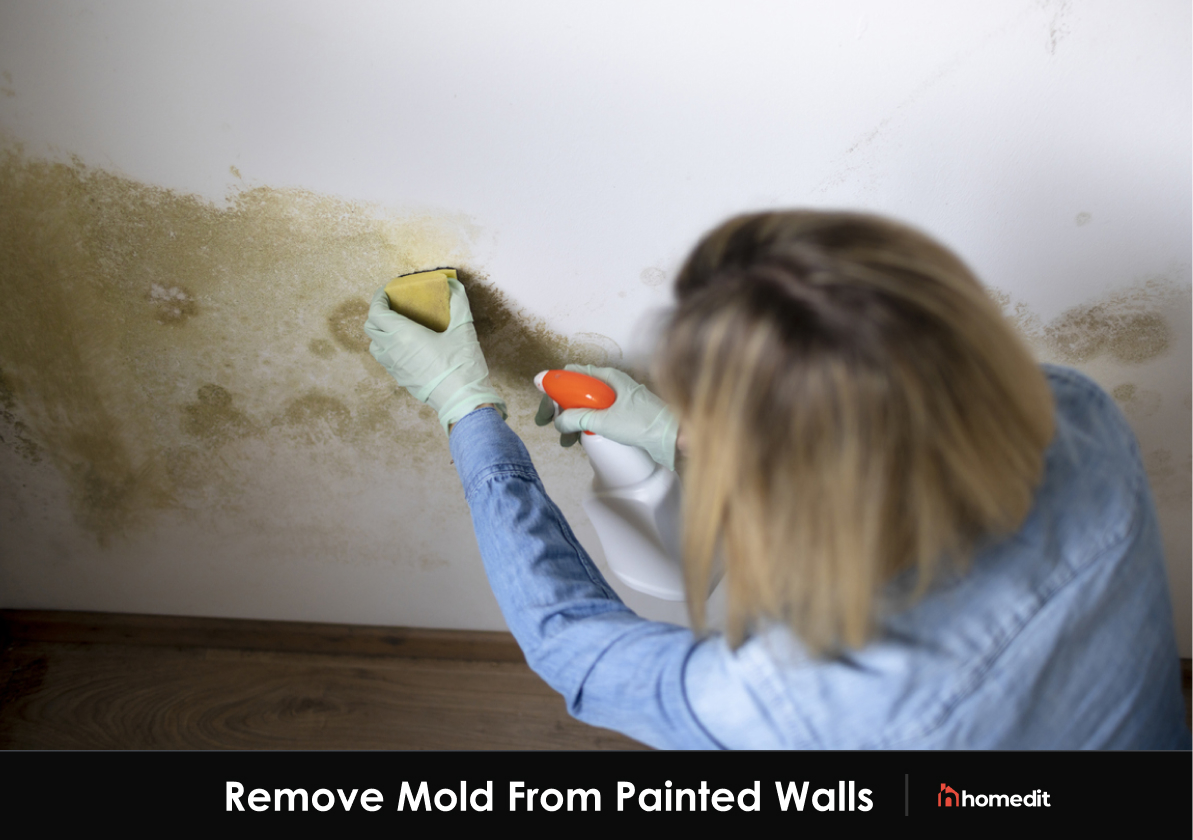The Most Effective Method for Removing Mold From Painted Walls
If you need to remove mold from painted walls, it’s safe to do it yourself as long as the mold covers no more than a 10-square-foot section.
While mold is never fun to look at or deal with, it’s a common household problem. It can occur almost anywhere there’s prolonged moisture, including your painted walls. If you have a plumbing leak, excess humidity in your home, or a wall that gets splashed with water regularly, mold can crop up.
There are two standard products to kill mold spores on walls: bleach and vinegar. Read below for the steps you need to take to banish mold for good, and the best product for killing this fungus at its roots.

How to Remove Mold From Your Painted Walls – Step by Step
Before you tackle the mold on your wall, put on safety gear. You’ll need a mask, gloves, and protective eyewear. You should also move furniture out of the way and lay a protective sheet on the floor. Then, follow these steps.
Step 1: Gather Your Supplies
To kill the mold, you’ll need white distilled vinegar, a spray bottle, and a scrub brush. Fill your spray bottle with three parts vinegar and one part water.
Step 2: Spray Your Wall and Scrub
Now spray the vinegar solution onto the wall and use your brush to scrub the problem area. Once you’ve removed the mold, lightly respray the wall, allow the solution to sit for 10 minutes, and then wipe the wall with a fresh towel.
Important note: If the paint sheen on your wall is semi-gloss or satin, this method won’t affect your paint job. But, if your wall has a flat or eggshell sheen, the vinegar and scrubbing can leave behind imperfections, and you may need to touch up the paint.
Is It Better to Use Bleach or Vinegar to Kill Mold on Walls?
It’s better to use white distilled vinegar to kill mold. Vinegar’s acidity kills mold at its roots, while bleach only kills surface mold. According to the EPA, bleach can leave mold spores behind to regrow.
What’s the Top Cause of Mold on Painted Walls?
Excess moisture is the top cause of mold on painted walls, which is why the bathroom is the most common place for mold to grow. Other culprits are excess humidity (often in the basement), water splashed on the walls during bath time, plumbing leaks, and roof leaks.
How to Prevent Mold from Growing Back on Your Walls
If you’ve rid your walls of mold and want to ensure it doesn’t come back, here are the four best steps to take.
- Ensure bathroom exhaust fans work—A common culprit of bathroom mold is an exhaust fan that doesn’t work. If the steam from baths and showers can’t escape the room, it will collect on the wall, giving mold a chance to grow.
- Teach kids not to splash water out of the tub – If there’s mold around the bathtub and you have young kids, splashing might be the problem.
- Monitor humidity levels – If your home is too humid (most common in the summer), it can cause mold issues. You can run a dehumidifier to reduce humidity levels. Humidity levels should never exceed 60%. Some studies suggest the ideal level is between 30% and 50% humidity.
- Fix plumbing or roof leaks – Any leak provides a breeding ground for mold and mildew.
Frequently Asked Questions (FAQ)FAQ
What does mold on a wall look like?
Mold on a painted wall most often looks like black or green splotches. But mold can appear in several colors, including orange, pink, brown, and yellow.
Will hydrogen peroxide kill mold on a painted wall?
Hydrogen peroxide kills mold on hard surfaces but doesn’t do well on porous surfaces like drywall. You can try treating the mold on your wall with peroxide, but it might grow back. To use peroxide, spray it on the mold, allow it to sit for ten minutes, scrub off, and then wipe dry.
Will vinegar kill mildew?
Vinegar will kill mold and mildew. So, if you’re dealing with both, use a combo of three parts vinegar to one part water, spray the area, and scrub the mildew off. Then respray the site and let the solution sit for ten minutes before wiping it away.
Final Thoughts
Removing mold from a wall is an easy process. In most cases, the mold will scrub right off. Then, spraying it with vinegar and allowing it to sit will help kill it at its roots. Just be aware that if you have flat paint, the vinegar and scrub brush might leave behind imperfections that require touch-up paint.
To prevent mold from reappearing, use vinegar and not bleach. Also, take the necessary steps to reduce moisture in the problem area.
